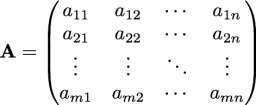The sum 17
The sum of the three numbers is -1. If we multiply the second number by 2, the third number by 3, and add them, we get 5. If we subtract the third number from the sum of the first and second numbers, we get -1.
Answer the following:
Represent the above information algebraically. Convert the system of linear equations into matrix form. If the matrix formed by coefficients of variables is written by A, then find |A|. Find adj (A), where the adjoint of A is the transpose of the matrix of the co-factors. Find the numbers using the matrix method.
Answer the following:
Represent the above information algebraically. Convert the system of linear equations into matrix form. If the matrix formed by coefficients of variables is written by A, then find |A|. Find adj (A), where the adjoint of A is the transpose of the matrix of the co-factors. Find the numbers using the matrix method.
Final Answer:

Tips for related online calculators
Do you have a system of equations and are looking for calculator system of linear equations?
You need to know the following knowledge to solve this word math problem:
algebraGrade of the word problem
Related math problems and questions:
- Properties: 2736
 Find four numbers whose sum is 48 and which have the following properties: if we subtract 3 from the first, add 3 to the second, multiply the third by three, and divide the fourth by three, we get the same result.
Find four numbers whose sum is 48 and which have the following properties: if we subtract 3 from the first, add 3 to the second, multiply the third by three, and divide the fourth by three, we get the same result. - Subtract 10001
 For five whole numbers, if we add one to the first, multiply the second by the second, subtract three from the third, multiply the fourth by four, and divide the fifth by five, we get the same result each time. Find all five of the numbers that add up to
For five whole numbers, if we add one to the first, multiply the second by the second, subtract three from the third, multiply the fourth by four, and divide the fifth by five, we get the same result each time. Find all five of the numbers that add up to - Subtract 82442
 I think of three numbers. When I add them, I get 15. When I subtract the third number from the sum of the first two numbers, I get 10. When I subtract the second number from the sum of the first and third numbers, I get 8. What number do I think?
I think of three numbers. When I add them, I get 15. When I subtract the third number from the sum of the first two numbers, I get 10. When I subtract the second number from the sum of the first and third numbers, I get 8. What number do I think? - Coefficients 55451
 Write a system of 3 linear equations with 3 variables (x. Y. z), which has all non-zero coefficients and a solution x= 2+t, y=3-2t, z=t, where t€R. The fact that the system has all non-zero coefficients means that all numbers in the extended matrix of the
Write a system of 3 linear equations with 3 variables (x. Y. z), which has all non-zero coefficients and a solution x= 2+t, y=3-2t, z=t, where t€R. The fact that the system has all non-zero coefficients means that all numbers in the extended matrix of the - Arithmetic sequence
 Determine the sum of the first 12 terms of an AP (arithmetic sequence) if a4 is equal to 7 and a8 is equal to minus 1.
Determine the sum of the first 12 terms of an AP (arithmetic sequence) if a4 is equal to 7 and a8 is equal to minus 1. - Subtract 82333
 I think of three numbers; when I add them, I get 16; when I subtract the third from the sum of the first two numbers, I get 10; when I subtract the second from the sum of the first and third numbers, I get 8. Which numbers do I think?
I think of three numbers; when I add them, I get 16; when I subtract the third from the sum of the first two numbers, I get 10; when I subtract the second from the sum of the first and third numbers, I get 8. Which numbers do I think? - Sequences AP + GP
 The three numbers that make up the arithmetic sequence have the sum of 30. If we subtract from the first 5, the second 4, and keep the third, we get the geometric series. Find AP and GP members.
The three numbers that make up the arithmetic sequence have the sum of 30. If we subtract from the first 5, the second 4, and keep the third, we get the geometric series. Find AP and GP members.
